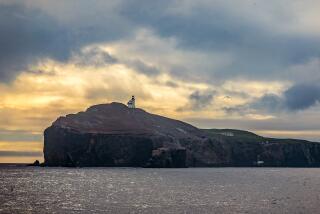An Islander Enjoys Nature’s Handiwork and His Own : Carving a Destiny
- Share via
He revved a four-wheel, all-terrain vehicle up an undulating hillside on Santa Cruz Island, eyeing the decomposing sheep carcasses that nature and hunters had left littered across the grassy slopes.
Pulling alongside one mound of dirty wool, the retired high school principal poked around for a spinal column from which he could carve one of the odd figurines that decorate his ranch house in the valley below.
But the bone proved too fragile, so he threw it back and set off again, chuckling as the roar of the bike scattered a herd of grazing sheep on this sparsely inhabited island 20 miles from the Ventura shore.
“I’m glad that I have this place of refuge,” he said. “The longer I’ve stayed out of the mainstream, the more I enjoy the solitude of a place like this.”
Meet Duane Owens--former principal of Ojai’s high school, island steward, Mormon church leader, family man, bone-carver.
Fit and muscular at 64, Owens has spent the last four years living alone on the eastern end of the 96-square-mile island, the largest of the eight Channel Islands.
He is there by virtue of his eldest son, Jaret, who had sought permission several years back to fly groups of ram hunters out to the island. Oxnard attorney Francis Gherini, whose family has owned the 6,700 acres of the eastern end since 1869, agreed to the arrangement on the condition that a caretaker be there at all times.
The senior Owens, having just retired from three decades of life in a jacket and tie, thought he would give it a try.
Since then, he has weathered loneliness and ocean storms, restored the century-old former sheep ranch where he lives, discovered muscles he says he never knew he had and produced a remarkable collection of carved sheep vertebrae, many of which bear portraits that closely resemble Owens himself.
“I’m sure he gets lonely, but not like the normal person,” said his wife, Doris, who comes to visit regularly from the family home in Ojai. “He tries to bring out the positive of any situation.”
A balding man with a gray beard and jutting chin, Owens scarcely leaves himself time to ponder his isolation.
Days Are Full
Rising before the sun, he puts in a full day pumping drinking water for several thousand wild sheep, chopping the firewood that allows him hot water, harvesting the squash and chili peppers that grow in his vegetable garden, cleaning up damage wreaked by fierce winter rains and raking flotsam from the small strip of sand that provides boating access to his camp.
At sundown, he fills up a bathtub and soaks away his aches. Solar panels provide electricity for his small television, but he seldom watches it. Before falling asleep, he might read a little from one of the bird-watching books at his bedside table.
“I don’t have that kind of unrestricted time to just fiddle around,” said Owens, a father of five who left the island only three times last year. “I’m driven by a work ethic, I guess.”
Still, to satisfy a lifelong passion for carving, he is often willing to put his daily chores on hold. In those moments, he will see a dragon in a knotty piece of driftwood, an impassioned preacher in a horse bone.
Most of all, he has found a way to carve sheep vertebrae so that they take on the sullen-eyed face of a bearded man, his cheeks deeply sunken where the bone curves in. Out of the back of the man’s head, where the bone juts out like a beak, Owens carves the faces of birds and wolves.
Dozens of individual vertebrae can be found scattered around his house on shelves or the fireplace mantle. Others, still stuck together in the form of a spinal column, sit on nails like miniature totem poles.
“The bone just sort of dictates what I do with it,” Owens said. “I just follow the bone.”
One of 12 children from a poor farming family, Owens grew up riding bareback and milking cows on a small ranch in Show Low, Ariz. With help from the GI Bill, he attended Brigham Young University in Utah, where he graduated with a bachelor’s degree in English.
After earning a master’s in educational administration from the University of Southern California, he moved to Ojai, where he took jobs as principal of Matilija Junior High School, Nordhoff Senior High School and Chaparral Continuation High School.
As strict a disciplinarian at school as he is in his faith, Owens later spent four years as a bishop in Ojai’s Church of Jesus Christ of Latter-day Saints.
“He is the sort of person that, if I had to make the westward trek, I would have wanted him on my wagon train,” said Freda Clegg, who for 21 years was Owens’ secretary in the Ojai Unified School District. “He is the basic pioneer.”
Reverence for Nature
Indeed, the stern-looking but good-humored man seems at home in the rugged splendor of Santa Cruz Island. He talks with reverence about the crisp sea air, the star-laden sky, the sheer cliffs, and the heavy silence that shrouds the place.
He makes sure his guests do not miss the golden eagle soaring by, or the pack of wild pigs frantically chasing a sow in heat, or the monarch butterfly fluttering out from an old eucalyptus grove.
At night, when he can see the lights of the shoreline and the distant flicker of cars on the freeway, he just smiles and wonders why anyone would want to live on the other side.
“To me, a visit to a place like this is a lot more valuable than a costly trip to a doctor,” he said. “There’s a tremendous tranquility here. . . . It’s something you feel that’s just difficult to explain in words.”
For most people, however, getting to the island is a bit of a journey.
Visitors usually take the two-hour ride to the eastern end on a tour offered by Island Packer Cruises, which sends a boat out from the Ventura Harbor nearly every weekend.
Visited in 1542
Originally inhabited by about 2,000 Chumash Indians, Santa Cruz Island was first visited in 1542 by Spanish explorer Juan Rodriguez Cabrillo. He was not impressed and wrote in his log:
“The Indians of these islands are very poor . . . . They live very swinishly and go about naked.”
The largest privately owned island in the continental United States, it was later given away as a Mexican land grant, then bought by a British trading company before finally being purchased by a French merchant named Justinian Caire in 1869.
After a long legal snarl several decades later, Caire and his heirs, the Gherinis, were left with the eastern one-tenth of the island and its two inlets, Smugglers’ Cove and Scorpion Anchorage.
The other nine-tenths belonged to physician-rancher Carey Stanton until his death in December, when it was turned over to the Nature Conservancy, an international environmental organization that preserves wild lands.
In 1980, Congress included the eastern end in the Channel Islands National Park and authorized the National Park Service to purchase it.
But Francis Gherini, who had opposed the takeover, said that negotiations to resolve the transfer of ownership have not yet begun.
For now, at least, it is still very much Duane Owens’ place. He has painted the old ranch and put in restrooms that say “Rams” and “Ewes” on the doors. He has landscaped the large outdoor courtyard with sheep skulls and jaw bones and horns. In a visitors’ house, he has set up a makeshift museum to display his unique carvings.
Not once has he longed for the ring of a phone or school bell, nor for the ring of authority.
“I haven’t looked back,” he said. “I keep seeing more to do.”
More to Read
Sign up for The Wild
We’ll help you find the best places to hike, bike and run, as well as the perfect silent spots for meditation and yoga.
You may occasionally receive promotional content from the Los Angeles Times.






